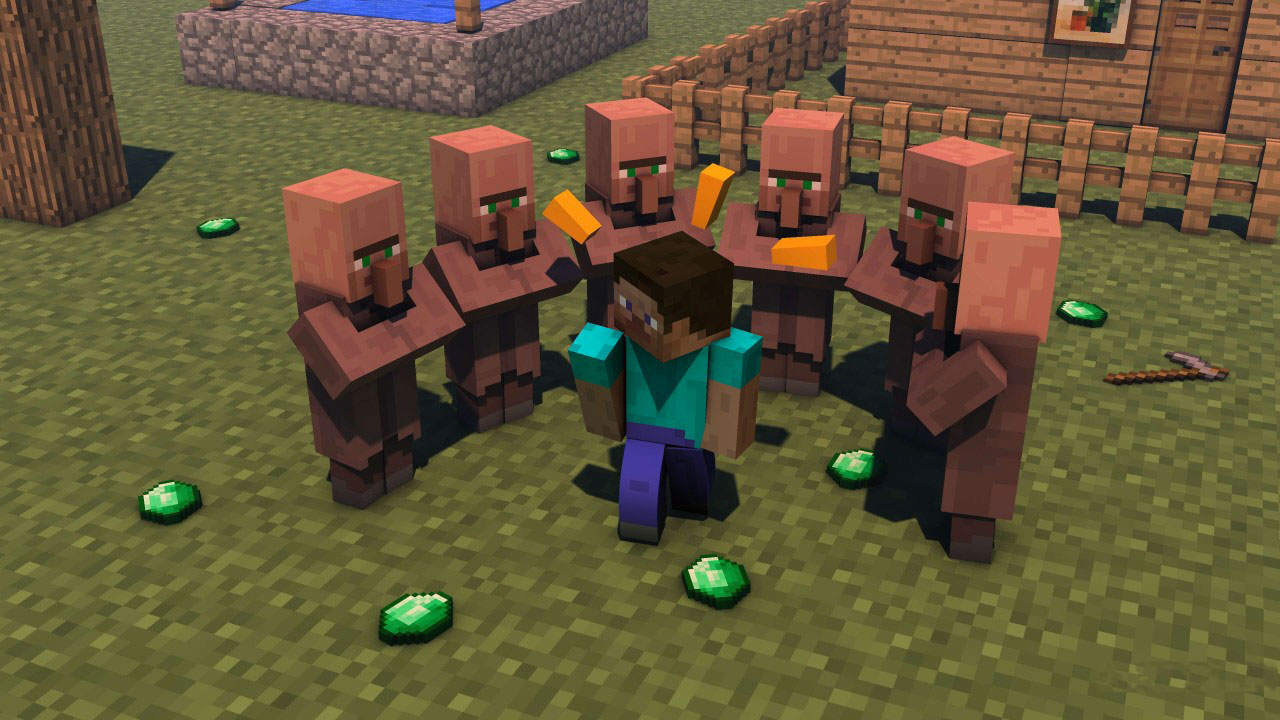Villagers, formerly referred to as Testificates, are passive Non-Player Character types (NPCs) that spawn and move around in Villages. They have different functions, such as religious leaders, butchers, blacksmiths, farmers, nitwit, and librarians and spawn within their respective buildings. They have got large, bald heads, green eye, mono-brows, and lengthy, Enormous noses.
Villagers are considered as one of the smartest of all peaceful mobs. However, there are some factors that they are unaware of or pay no attention to. Villagers realize the day and night routine aswell. Villagers aren’t fond of water, and unlike the various other relaxing mobs, will instantly attempt to find an escape route. Villagers will try to prevent zombies. However, they do not attempt to escape any attackers except zombies. Unlike additional mobs, villagers usually do not notice if they are established on fire, making any source of fire extremely harmful to a village’s population. Villagers won’t run if they are on fire aswell, demonstrating no attempt to place the fire out.
Villagers only spawn in villages which can be located only in the flattest (or near to smooth) biomes, such as for example desert biomes, savannas, and plains. When a villager notices a zombie, they immediately start to hightail it from their website. Villagers are fast more than enough to escape a zombie. Nevertheless, this will not constantly protect them. When it becomes nighttime, all villagers move in-doors to basic safety. However, there is a flaw in this behavior. Whenever it is raining outside, villagers still recognize it as time. Zombies, however, won’t die because it is normally raining, and sunlight is not out. This may cause some villagers to die. Villagers may also run apart when they visit a Vindicator or an Evoker.
A common view in a village will be villagers facing each other, assuming the human-like feature of “talking”. When a player attacks a villager, they possess steam coming from their heads, most-most likely indicating anger or frustration. By 1.6, villagers will make noises (sounding similar to a “hmmm”, a grunt, or a humming sound). They make noises on several events: when breeding is usually activated, when hit by a player, or whenever a player trades with one.
Trading with Villagers
Villagers are able to be bartered with in the game for various products based on their “job” or type of villager. The currency that they deal with are emeralds. Some villagers will trade for emeralds, while some will take emeralds and present items. Farmer type villagers, known because of their brown clothes, are recognized to trade items related to farming, such as wheat, carrots, potatoes, and melon seeds for emeralds, or vice versa. The butcher type, known for the dark brown clothing and white apron, will trade for meat such as porkchops, beef, mutton, and chicken. It is a lot more common for the trade to need the raw edition of the meats. Priests, which can be acknowledged by their full purple clothing, trade for Ender Pearls and Eyes of Ender. They also permit the player to get enchanted items by trading an unenchanted edition of that, and a few emeralds as the expense of enchanting the item. The blacksmith type of villager trades for armor and tools and weapons. The librarian villager is known for his all-white clothing and “intelligent” look, buys paper and markets reserve and navigational related items, such as for example bookshelves and compasses. Finally, there is an added villager called the Nitwit, it wears a green robe and will not trade when one right clicks him.
Villagers all focus on one trade agreement. Once the participant will this trade and then closes the trading user interface, the villager could have a “thinking” type animation and develop another trade. This will two things. First, it allows more trading options, up to a maximum of 5 per villager, and second, it resets the trade. Each trade can be used 3-5 instances until it should be reset again. The villager will only reset if the ultimate or “newest” trade is completed one or more times. Once all five are unlocked, continuing the last trade will continue steadily to reset the trades, and also has a little potential for replacing a preexisting trade with a new one.
Trading is one of the fastest methods for getting emeralds legitimately in survival mode without the use of cheats, seeing that farming pets and crops are much faster than digging for emeralds. This allows players to continuously trade and renew trades that yield emeralds to the player. This is also known sometimes as “farming emeralds”, or “emerald bartering.”
By Minecraft 1.8, the villagers’ trading got a major upgrade. Villagers could will have many trades when they are spawned offering the player more versatility when trading. Another element that helps is certainly that when trading, new trade possibilities may appear depending on just how many brand-new trades players have made already.
The Exploration Update added new “cartographer” villagers, who’ll trade their Exploration Map for a Compass and varied levels of Emeralds gathered by the player.
Popularity with Villagers
A player’s recognition within a particular village can be increased or decreased in many ways, with one notable consequence: if the player has a recognition below -15, naturally spawned Iron Golems will become permanently hostile towards the participant. Popularity could be gained by trading, breeding, etc., but will decrease by attacking villagers and/or iron golems. A player’s popularity can be saturated in one village, however low in another.
Zombie Villagers
Zombie Villagers are aggressive mobs that appeared in Minecraft’s Pretty Scary Upgrade (Edition 1.4). They make up 5% of zombies that spawn in the Overworld. They’ll also show up after a villager can be killed by a zombie throughout a village siege, 50% on Normal and 100% on Hard. If a baby villager can be killed during a siege, it will also turn into a baby zombie villager. Baby zombie villagers are faster than their grown-up counterparts and will not age. Zombie villagers can be returned to normal villagers if weakened using a splash potion of weakness, and then fed a golden apple.
They will actually shudder while being cured. It is best to place zombie villagers in sort of “prison cell” structure with a bed and iron bars while treating it. That is because the iron pubs and bed make the villager cure about 4% faster. Zombie villagers consider 2-5 moments to treatment under normal conditions. A zombie villager provides all the behaviors and features of regular zombies, such as for example being able to wear armor. Iron golems will still strike them unless they are healed. In Pocket Edition and 1.9, they maintain their clothes and appearance prior to being infected.

